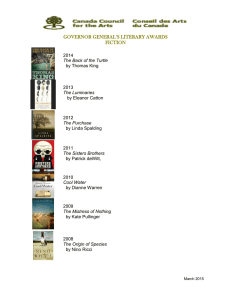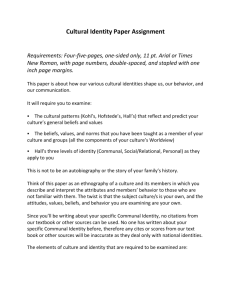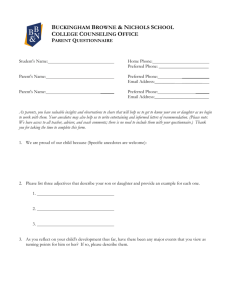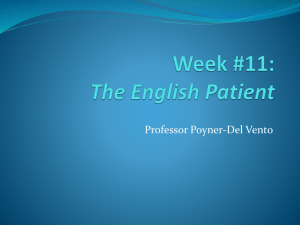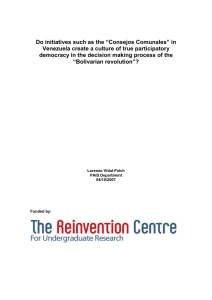Seminar on Running in the Family MN = marking notes (2014a
advertisement
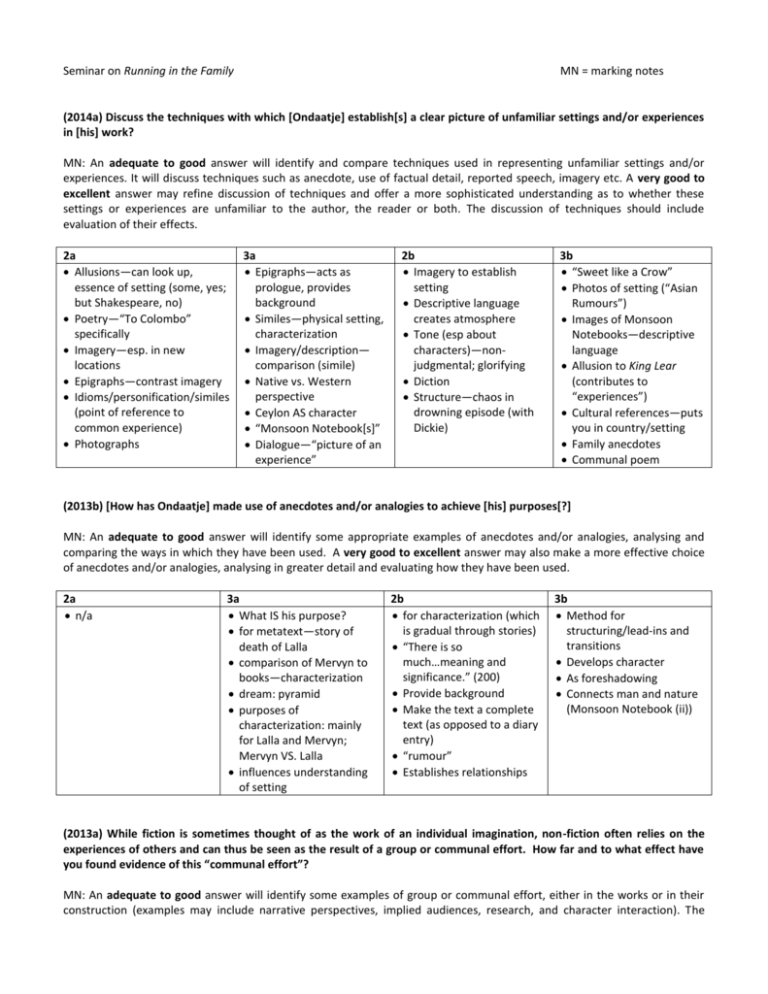
Seminar on Running in the Family MN = marking notes (2014a) Discuss the techniques with which [Ondaatje] establish[s] a clear picture of unfamiliar settings and/or experiences in [his] work? MN: An adequate to good answer will identify and compare techniques used in representing unfamiliar settings and/or experiences. It will discuss techniques such as anecdote, use of factual detail, reported speech, imagery etc. A very good to excellent answer may refine discussion of techniques and offer a more sophisticated understanding as to whether these settings or experiences are unfamiliar to the author, the reader or both. The discussion of techniques should include evaluation of their effects. 2a Allusions—can look up, essence of setting (some, yes; but Shakespeare, no) Poetry—“To Colombo” specifically Imagery—esp. in new locations Epigraphs—contrast imagery Idioms/personification/similes (point of reference to common experience) Photographs 3a Epigraphs—acts as prologue, provides background Similes—physical setting, characterization Imagery/description— comparison (simile) Native vs. Western perspective Ceylon AS character “Monsoon Notebook[s]” Dialogue—“picture of an experience” 2b Imagery to establish setting Descriptive language creates atmosphere Tone (esp about characters)—nonjudgmental; glorifying Diction Structure—chaos in drowning episode (with Dickie) 3b “Sweet like a Crow” Photos of setting (“Asian Rumours”) Images of Monsoon Notebooks—descriptive language Allusion to King Lear (contributes to “experiences”) Cultural references—puts you in country/setting Family anecdotes Communal poem (2013b) [How has Ondaatje] made use of anecdotes and/or analogies to achieve [his] purposes[?] MN: An adequate to good answer will identify some appropriate examples of anecdotes and/or analogies, analysing and comparing the ways in which they have been used. A very good to excellent answer may also make a more effective choice of anecdotes and/or analogies, analysing in greater detail and evaluating how they have been used. 2a n/a 3a What IS his purpose? for metatext—story of death of Lalla comparison of Mervyn to books—characterization dream: pyramid purposes of characterization: mainly for Lalla and Mervyn; Mervyn VS. Lalla influences understanding of setting 2b for characterization (which is gradual through stories) “There is so much…meaning and significance.” (200) Provide background Make the text a complete text (as opposed to a diary entry) “rumour” Establishes relationships 3b Method for structuring/lead-ins and transitions Develops character As foreshadowing Connects man and nature (Monsoon Notebook (ii)) (2013a) While fiction is sometimes thought of as the work of an individual imagination, non-fiction often relies on the experiences of others and can thus be seen as the result of a group or communal effort. How far and to what effect have you found evidence of this “communal effort”? MN: An adequate to good answer will identify some examples of group or communal effort, either in the works or in their construction (examples may include narrative perspectives, implied audiences, research, and character interaction). The answer will include adequate comparison of the effects of communal effort within the chosen works. A very good to excellent answer may offer more persuasive examples of group or communal effort in a convincingly developed analysis. The answer will explore the subtleties of the question and offer an effective evaluation of the contribution of communal effort within the chosen works. 2a Acknowledgments/ raw material Family quotations, dialogue, anecdotes— keep things fresh, diff. perspectives on ppl/subjects Mentioning names of people Epigraphs and graffiti (intertextuality)—sharing experiences 3a Conversations/dialogues “rumours” Perspectives Exaggeration=imagination Fact influences fiction; fiction depends on nonfiction Imaginative aspects created based on characters’ personalities 2b “Dialogues” Developed by family members’ “individual imagination” structure 3b “Dialogues”/”Lunch Conversations” “Women like You”— “communal poem” Acknowledgements— writing about the writing Enhances picture of family (through multiple perspectives) Fictionalized moments— Lalla’s death Ellipses in portions where story is unclear or unfinished for Ondaatje Disjointed structure reflects Ondaatje’s own journey to answers (IBO sample) Discuss the way [Ondaatje has] structured [his] work to make [his] material clear and interesting to [his] audience. MN: An adequate to good answer will identify some structural features of at least two works (by two writers) and compare the effectiveness with which these features help convey the content in a clear and interesting fashion. A good to excellent answer may offer some telling comparisons between the structuring of the works and the effects these structures have on clarity and interest. 2a Short chapters Punctuation (more related to syntax) Lack of consistent chronology Introducing characters as needed Dialogue Journal entries, poetry (break from prose) Separations from remainder of text 3a (5 min left) Pieced together by end; connections between chapters Structure—more clear, if not more interesting Like a diary Clear and interesting not the same thing Metatext (makes it interesting) 2b “in hindsight” Forced connections Structure contributes to interest, not clarity 3b “Asia” and “The Bone” Photographs Intertextuality enhances clarity structure
